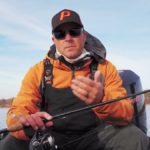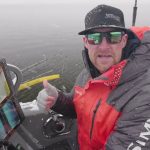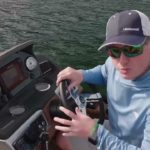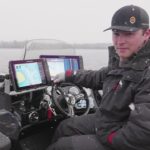Finally, It is Shiver Time
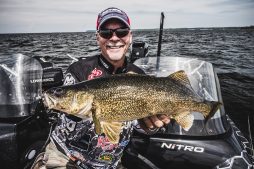
One rod, one lure, searching for big fish. It is like bowhunting for walleyes. Scout the water with the Lowrance electronics, find the right fish, then we take our shot.
Colder spring temps and excess water in areas combined this year to delay the arrival of the need to use Moonshine Shiver Minnows to trigger walleyes. The fish are generally surrounded by food by this point in the year and stop responding to traditional presentations. Aggressive predators still react to erratic, fast-moving baits and walleyes will hit well-presented lures from now throughout the fall.
The gain in this scenario comes from larger fish mixing with smaller fish. Colder water temperatures and limited natural food in the spring forces the big fish to find separate feeding grounds on their own while smaller fish school up on easy-to-locate structural areas. Eventually, the bounty of the summer bug and baitfish hatches changes the general pattern.
The choice of lure for hunting single walleyes on structure is simple: The Moonshine Shiver Minnow is designed for casting and comes in walleye-specific sizes and colors. Sometimes our boat only has two or three rods rigged up with a Shiver Minnow while we launch in search of specific fish we first find on our sonar. In some ways it is simpler than the spring time bites but the devil is in the details.
Finding fish on structure is the first hurdle. Some fall walleyes are still chasing bait in the open water while others hole up in weeds leaving fewer fish on drop-offs. The difference is that the structure fish are easiest to target and catch so it is worth the time to find even one or two fish and try to catch them all.
We spend extra time in search mode using our Lowrance electronics. Lowrance HDS palette 13 set at sensitivity A*2 is our favorite setting for this effort. When we spot a fish a way point goes directly on the mark. If the fish is in deeper water (20 feet or more) we simply command the Motorguide Xi5 trolling motor to electronic anchor on the spot. In shallower water we move downwind and electronically anchor less than a cast away. Since every boat on the lake is using the same lure, boat control, cast accuracy, and presentation details become critical. Over-fed walleyes will move a small amount for a good presentation, but generally will not chase a lure over longer distances.
Tackle has evolved to help cast, jig, hook, and land big walleyes on Shiver Minnows. The new Cabelas Prodigy 6’3” X-tra Fast Medium-Light or Medium rod was designed specifically for this presentation and works great. Its light weight prevents arm fatigue during full day of working heavy lures in deep water. The strong backbone quickly responds and moves the heavy lure through the mouth of an angry, clamped-down walleye and pulls the hook into the jaw. Use the medium light rod for smaller waters and generally smaller lures and fish, but jump up to the medium action for larger lures and deeper presentations.
Our team used to switch back and forth between Berkley Fireline and Berkley Nanofil for Shiver fishing but now we all agree. The new Berkley Fireline Ultra-8 Carrier is a mix of the two lines with the smoothness of Nanofil due to the four extra carriers and the abrasion resistance and strength of the original Fireline braid. In most walleye situations we use 10-lb test but moving up to 14-lb test is sometimes necessary for heavy cover, zebra mussels, or bigger fish.
Berkley 100% Fluorocarbon leader material in 10, 12, or 15-lb test makes a great connection between the braid and lure. Two feet of fluorocarbon is generally enough even in clear water and greatly reduces the number of times the leader knot goes through the guides of the rod.
The combination of braid and fluorocarbon creates an ultra-sensitive connection between the rod and lure so the angler can sense every change in bottom composition as well as every bite. The weakness in this system is that the no-stretch line and heavy lure give the angler no room for error when fighting a big fish. In this case we change out the Shiver Minnow hooks with a larger #6 Berkley Fusion 19 treble hook for better hooking and here is another reason for the Prodigy rod—it has a softer tip with more give so we can keep continuous pressure on the hooked walleyes.
A few final tricks to out-fish everyone else in the boat. If the boat driver finds a mark and wants to cast keep an eye on the orientation of the boat, wind, and fish. Since it is common to be well offshore, it can help to watch bubbles or a specific spot in the wake of the boat while the driver maneuvers. When in doubt, throw a buoy to make sure every cast has the opportunity to bounce in front of a walleye.
After the lure hits the bottom jig it up and immediately give the lure some slack. Keeping tension on the lure will reduce the side-to-side action that makes Shiver Minnows special. After a spring season of standard jigging the slack seems unnatural but it makes a huge difference in the number of bites. While working with co-anglers in tournaments the key description is that the right motion creates a loop of line near the rod tip and involves a solid snap at the beginning of the stroke. Similarly, if the lake bottom is covered in moss, algae, or mussels timing your jigging stroke to stay above the bottom increases bites over time.
Finally, vary the height and number of jig strokes before letting the lure crash back down to the bottom. Many times, larger jumps will trigger fish but just as often this will pull the lure out of the strike zone. At the same time, fish occasionally suspend off the bottom and a larger stroke attracts their interest. Work both ends of the spectrum until a trend emerges. Do not forget to change colors and even sizes as well throughout the day. Larger fish generally eat larger lures but sometimes the opposite is true.
Casting Shiver Minnows to specific fish is not a numbers game. A handful of bites a day is a good goal. The mindset of reacting to one good mark on the Lowrance takes a bit of adjustment after spending all spring trolling and jigging to schools of fish. As an angler, the difference that keeps us going all fall is that the largest fish of the year can easily come on the Next Bite.


